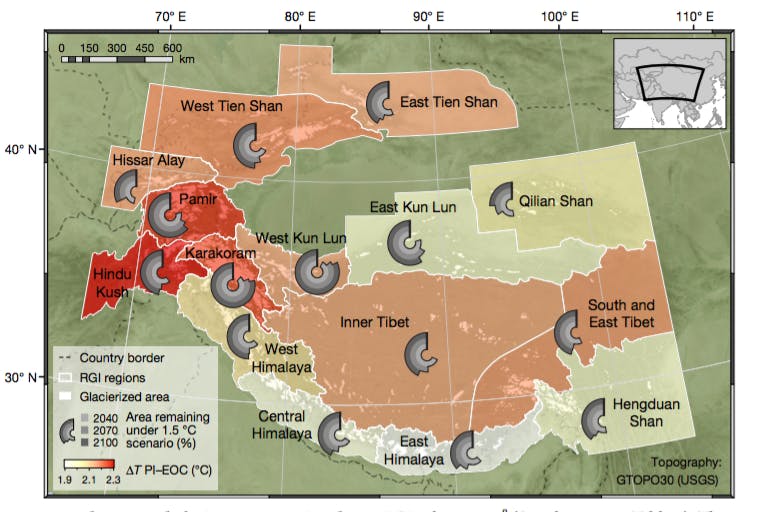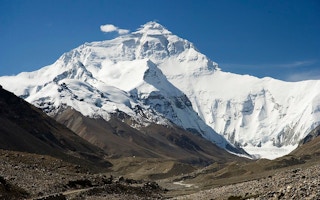These glaciers provide water to at least 800 million people living in Asia.
However, it could be too late to save all of Asia’s iconic snowy landscape, the lead author tells Carbon Brief. The research finds that, if global greenhouse gas emissions were stopped today, 14 per cent of Asia’s glacier ice would still disappear by the end of the century.
And, if no efforts are made to curb global greenhouse gas emissions, two-thirds of the glacier ice in Asia’s high mountains could vanish by 2100, the study says.
The great melt
Glaciers are huge rivers of ice that ooze their way over land, powered by gravity and their own sheer weight. The thousands of glaciers that are strung across the high mountains of Asia contain the largest store of permanent ice and permafrost outside of the North and South poles.
Despite its snowy exterior, the mountainous region is expected to warm up at a faster pace than the surrounding low-lying land as global temperatures rise.
This is partly because snow has a high albedo, which means it reflects a high proportion of the sunlight back into the atmosphere, says Philip Kraaijenbrink, a PhD student at Utrecht University in the Netherlands and lead author of the new study published in Nature. He tells Carbon Brief:
“Snow reflects a large part of the incoming radiation, up to 90 per cent, which means it has a high albedo. And a high snowline consequently means that more energy stays at the Earth’s surface.”
In other words, as the glaciers retreat, they expose more of the dark, rocky ground beneath. This means the land then absorbs more of the sun’s radiation and heats up more quickly, melting more ice.
“
We have already considerably warmed the earth since the industrial era and we have caused an imbalance of the glaciers as a result. At the moment, we observe their retreat almost everywhere on the globe.
Philip Kraaijenbrink, researcher, Utrecht University
The study is the first to use mathematical modelling to investigate how the ice stored by Asia’s glaciers will fare under a range of future global greenhouse gas emissions scenarios.
Whether a glacier retreats or advances each year largely depends on its “mass balance” – the difference between how much snow it receives and the amount of its ice that melts away. Glaciers that lose more mass through melting than they gain from snow will shrink and retreat back up the valley.
Using their glacier mass balance model, the researchers ran simulations of a world that was 1.5C warmer than pre-industrial levels. All of these simulations are based on the “RCP2.6” scenario, which assumes that greenhouse gas emissions peak between 2010 and 2020.
Under 1.5C of global warming, Asia could lose around one third of the ice stored in its glaciers by 2100, compared with levels of ice observed from 1996 to 2015, the researchers find.
And under a “stabilisation” scenario, which assumes that greenhouse gas emissions will level off around the middle of this century (RCP4.5), half of Asia’s glacier ice could disappear by the end of the century.
However, two-thirds of Asia’s glacier ice could be lost by 2100 if no efforts are made to prevent climate change (a scenario called RCP8.5), the researchers find.
The researchers also find that, if global greenhouse gas emissions were halted today, 14% the ice stored in of Asia’s glaciers would still vanish by 2100. This is because it takes several decades for the full effect of recent warming on the glaciers to play out, Kraaijenbrink says.
Asia’s changing snowscape
The map below shows how the impact of 1.5C of global temperature rise varies across Asia’s glaciers. On the map, colour is used to indicate the localised impact of 1.5C of global average warming, with white indicating warming of 1.9C and red showing warming of 2.3C.

Map showing the impact of 1.5C of warming on glaciers in the High Mountains of Asia (HMA). Colour indicates protected change in temperature from pre-industrial times to the end of the century, with white indicating warming of 1.9C and red showing warming of 2.3C. Grey circles indicate the projected amount of glacier that will remain under 1.5C of warming by 2040 (light grey), 2070 (medium grey) and 2100 (dark grey). Source: Kraaijenbrink et al. (2017)
The map also includes grey circles that indicate the projected amount of glacier ice that will remain under 1.5C of warming by 2040 (light grey), 2070 (medium grey) and 2100 (dark grey).
The difference in projected ice loss can be explained in part by differences in the amount of debris that sits on top of each glacier. Debris, such as large rocks and stones, are picked up by glaciers as they carve their way through mountain valleys.
Depending on its thickness, this debris can either suppress or enhance ice melt. Thin debris accelerates melt because it absorbs more heat than debris-free ice. However, thick debris can act as a blanket buffer, protecting the ice beneath from changes in temperature.
This explains why the Hissar Alay, a mountain range spanning the territory of Tajikistan and Uzbekistan, and the Qilian Mountains in China show the most extreme decline, with only 32 per cent and 30 per cent of their ice expected to remain, respectively, by 2100 under 1.5C of warming. The glaciers in both of these mountain ranges are scattered with only a thin layer of debris.
It could also explain why the Karakoram, a large mountain range spanning the borders of Pakistan, India, and China, could retain up to 80 per cent of its ice by 2100, despite experiencing a high level of regional warming.
(Carbon Brief has previously reported on the shrinking and surging of the Karakoram’s glaciers.)
Glaciers in the Karakoram are covered in a thick layer of debris and so could be better able to cope with global warming, Kraaijenbrink says.
“The large glaciers of the Karakoram lose the least mass, percentage wise. This is however the region with most ice, and although 80 per cent of the ice remains there in a 1.5C scenario, this would still mean an absolute loss of about 325bn tonnes of ice. This is roughly equal to the entire glacier mass of the Tibetan Plateau and Qilian Shan combined.”
Understanding the effects of debris has allowed the researchers to get a more detailed view at how ice loss could vary from region to region, says Dr Ben Marzeion, a climate scientist from the University of Bremen who was not involved in the study. He tells Carbon Brief:
“The study shows that the insulation effect of debris will not save the glaciers of high mountain Asia from global warming because the overall mass losses it projects are similar to previous studies that did not consider the effect of debris cover. However, the spatial distribution of mass loss is different.”
A dry future?
The loss of glacier ice from the Asia’s high mountains could spell bad news for millions of people living in China, India, Nepal, Russia and Kazakhstan.
Currently, meltwater from the glaciers provides a relatively steady supply of water to the rivers during the annual melt season. This water is used for irrigation, drinking water and hydropower.
Climate change could increase the rate of ice melt and, as a result, lead to a sharp increase in the supply of meltwater in the coming decades, Kraaijenbrink explains.
“However, as the glaciers lose ice, they retreat and their surface area becomes smaller. Less and less of the glacier’s surface becomes available for melt, resulting in a gradual drop of the glacier discharge [meltwater] at a certain point in time. This point is known as peak meltwater.”
It is not yet known exactly when “peak meltwater” could occur, he says, but his projections suggest it could happen as early as 2030, under both RCP2.6 and RCP4.5.
However, simulating changes to local water resources requires an understanding of all of the complex factors that contribute to river flow, notes Dr Alex Gardner, a scientist at the NASA Jet Propulsion Laboratory in California, who was not involved in the research. He tells Carbon Brief:
“The study stops short of identifying the implications of the glacier loss on local water resources. To answer this question you need to understand how seasonal stream [river] flow would be modified under these different [emissions] scenarios.”
Glaciers typically only supply a small fraction of the total yearly flow of water to a river, he says. However, glaciers can have have a large influence on the timing of water availability.
“Glaciers store water in cold often wet times of the year and release it during warm summer months when other sources of streamflow may be in short supply. This augmented supply of water, through glacier storage and runoff, can be critical when other sources are absent.
“To fully understand the implications of the projected glacier loss on future stream flows will require understanding the resultant change in river input, relative to other sources, upstream of dependent populations.”
Protecting the ice
Another finding from the new research is the extent to which thick debris could protect glaciers from global warming.
Because of this, it is possible that dropping a thick layer of stone and rock on top of debris-free glaciers could help to protect them from future warming, Kraaijenbrink explains.
“Covering debris-free glaciers with a thick layer of debris will indeed help to reduce ice melt and retain the glaciers in the landscape for a longer period. However, this would be a very large undertaking and our efforts may be better aimed at reducing the causes of climate change and glacier mass loss.”
He adds that it may be too late to stop all of the ice from melting.
“We have already considerably warmed the earth since the industrial era and we have caused an imbalance of the glaciers as a result. At the moment, we observe their retreat almost everywhere on the globe.
“Consequently, I do not think that we as mankind can do anything about an, at least considerable, loss of the world’s ‘Third Pole’.”
This story was published with permission from Carbon Brief.










